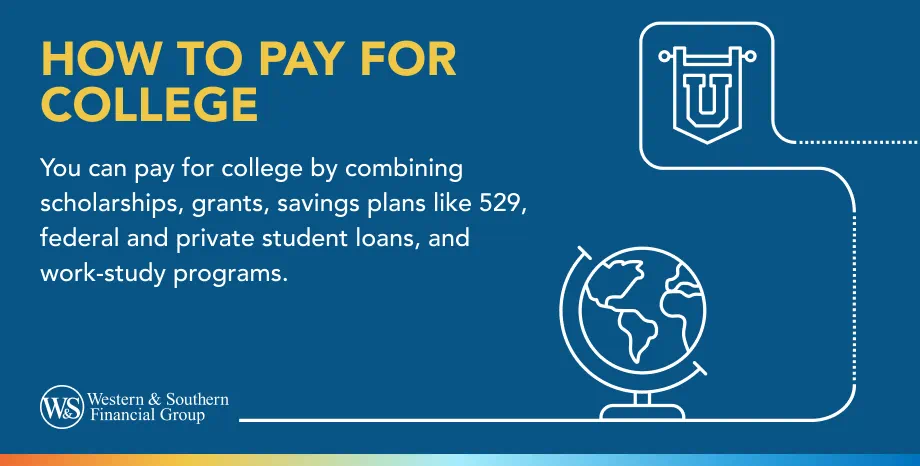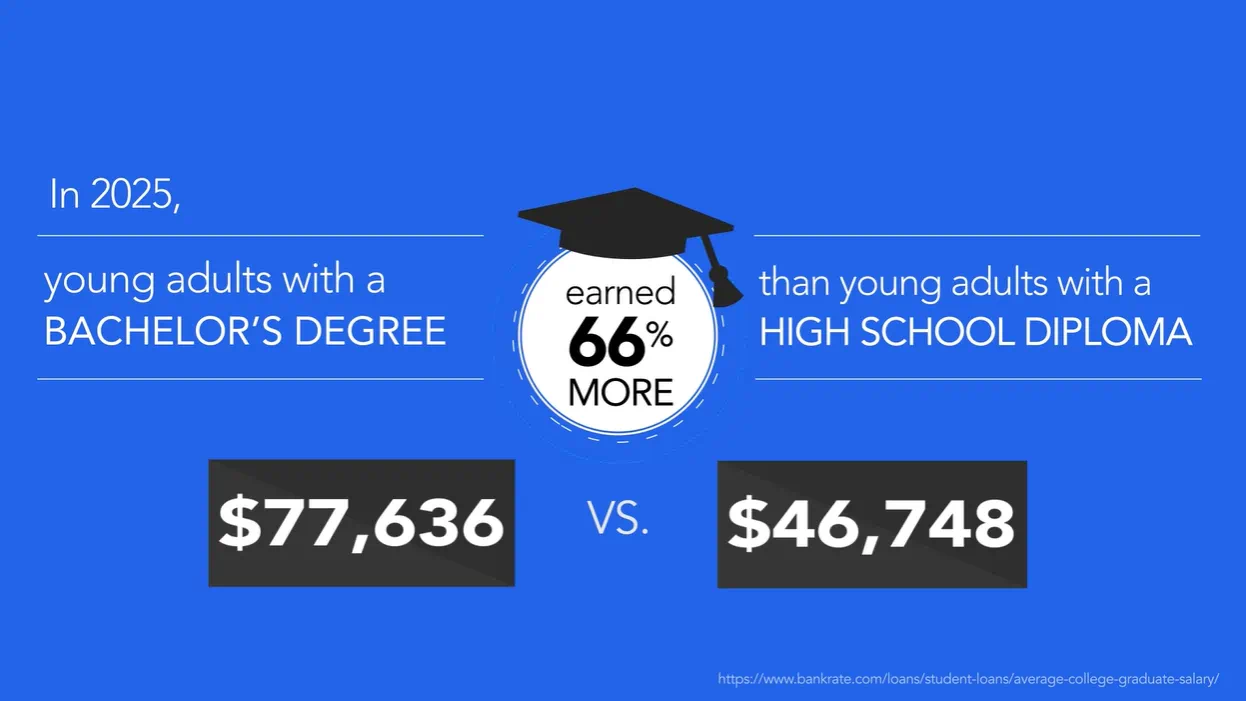Video Transcript
Opportunity
Education is the most powerful weapon which YOU can use to change the world. –Nelson Mandela
Challenge
1The average 2024-25 tuition increase was 3.9% at private colleges. The average sticker price for a public 4-year in-state college is $11,610.
1According to trends in College Pricing & Student Aid 2025, over the 3 Decades between 1994-95 and 2024-25, published in-state tuition and fees at public four-year institutions increased from $5,740 to $11,610.
1In 2025, young adults with a bachelor's degree earned 86% more than young adults with a high school diploma. $77,636 vs. $46,748.
Funding a higher education. Are you ready?
Talk to your Western & Southern Life representative to see if a 529 plan or the death benefit and cash value accumulation potential of a life insurance policy may help you with your college planning needs.
Western & Southern Life is the marketing name for The Western and Southern Life Insurance Company, Cincinnati, Ohio. The Western and Southern Life Insurance Company, Cincinnati, OH.
Securities are offered by registered representatives through W&S Brokerage Services, Inc. (W&SBS), member FINRA/SIPC. Both companies are members of Western & Southern Financial Group.
© 2025 Western & Southern Financial Group, Inc. All rights reserved.
VID1237 2403
1Trends in Higher Education. 2024. The College Board.
Key Takeaways
- In 2024-25, average tuition and fees were around $11,000 for public universities and $43,000 for private universities.1
- College is a significant expense that demands careful financial analysis.
- 529 savings plans let you invest tax-free for college expenses, with annual contributions up to $19,000.
- Submitting the FAFSA early helps determine eligibility for federal grants, loans, and other aid, as funds are limited.
- Scholarships from schools, employers, and nonprofits offer funds that don’t need to be repaid, so apply before and during college.
Cost of Tuition and Fees
A college degree can be one of the best investments for your career. The average college graduate earned on average $1,500 per week in 2024.2 And as you're figuring out how to pay for college, you also need to consider room and board, books, supplies and other expenses. Fortunately, there's a wide range of different programs available to help pay for college.
Whether you're going back to school or financing college for your child, it might help to consider all the available options for managing the costs. Here are some common strategies to help you put together your college payment plan.
529 Plans
If you still have several years before you or your child will go to college, you could build up your savings through a 529 plan. Just keep in mind that no investment in 529 plans guarantees growth and you could lose your initial investment.
Maximum Savings for 529 Plans
There are also no income restrictions, so you can use these accounts no matter how much you earn, according to the IRS.4
Each state runs its own 529 program, and while your state may offer incentives to win your business, you can choose to use another state's 529 plan. There are two types of 529 plans:
Savings Plans
With a 529 savings plan, you put money aside and then grow your savings through investments like stocks, bonds and mutual funds. As long as the money stays in the investment account, you won't owe taxes on your gains.
Then, when you spend the money on qualified educational expenses like tuition, room and board, and books, you also won't owe taxes on qualified withdrawals. Depending on your state of residence, you may also receive a state income tax deduction. However, 529 plans do not offer a federal tax deduction.
You must spend the funds in the 529 plan on qualified education expenses. Otherwise, you'll owe income tax and a 10% penalty when you take out your investment earnings.
Prepaid Tuition Plans
Under a 529 prepaid tuition plan, you buy credits that count for tuition and fees at today's current rates.5 That locks in the price so you don't have to worry about costs going up. The 529 prepaid tuition plan will list which schools qualify, and you can pay for tuition in one lump sum or through installment payments. If you or your child end up attending a different school, however, the money will not be lost. Most prepaid tuition plans allow you to use money from the plan to pay tuition at other colleges and universities, but the details around this vary by state.
Coverdell Accounts
Coverdell accounts are another way to save for college expenses. They have the same tax benefits as the 529 plan: delayed taxes on investment gains and tax-free withdrawals when you spend the money on qualified education expenses.
Coverdell plans only allow you to save $2,000 per year, and there are income restrictions on who can use them, according to the IRS. You can only save through a Coverdell if you're single with a gross income of $110,000 or less, or if you're married and have a joint income of $220,000 or less.
Compare Coverdell accounts and 529 plans to find the best savings tool for college. Invest Today
Federal Student Financial Aid
There are two main types of federal financial aid: grants and loans. With grants, you don't have to pay the money back. The government or school just gives you money to help cover your college costs. With loans, you do have to pay the money back.
To start the financial aid process, you fill out the Free Application for Federal Student Aid (FAFSA) to detail your family's financial situation. The federal government will use this information to see whether you qualify for federal financial aid. You may reference the U.S. Department of Education website for application deadlines in a given year, but consider applying as early as you can because programs may run out of money as more people apply.6
You can also submit your FAFSA information to your state's financial aid office and to the schools you're applying to in order to see whether they will give you support as well. Even if you think your income and savings are too high to qualify, this application is free, so you may want to apply.
Subsidized & Unsubsidized Loans
Subsidized and unsubsidized loans are two types of loans that are available for eligible undergraduate, graduate and professional students. Eligibility for subsidized loans is based on financial need, while unsubsidized loans do not require applicants to demonstrate financial need.
Financing college with federal loans can have several advantages compared with private loans. First, these college loans are easier to qualify for. As long as you're using the money to pay for qualified college expenses, you will likely qualify to borrow some amount of money. It's not like applying for a private loan, where companies often look at your credit score.
In addition, you don't have to make payments on your loan while you're in school. But if you do have some room in your college budget, consider making at least some payments, as this can help you get out of debt more quickly. Finally, after you graduate there are options to delay payments on federal loans, like requesting a hardship deferral because you're unemployed.
Parent PLUS Loans
Parents can also take out federal student loans on behalf of their children through the Parent Loan for Undergraduate Students (PLUS) program.7 These loans are made in parents' names, and they will be financially responsible for paying off the debt, not the student.
Before setting up a PLUS loan for your child, consider whether you will still be able to keep up with your other financial goals, like retirement. After the student graduates, they could also refinance the PLUS loans to take over payment themselves.
Federal Loan Limits
There is a limit to how much you can borrow through federal loans, according to the U.S. Department of Education.8 As of 2024, the most money an independent student (and dependent undergraduate students whose parents are unable to obtain PLUS Loans) can borrow through subsidized and unsubsidized loans is $57,500 — and no more than $23,000 can be subsidized loans. Dependent students, except for those whose parents are unable to obtain PLUS Loans, can borrow up to $31,000 — and no more than $23,000 can be subsidized loans. Graduate or professional students can borrow up to $138,500 — and no more than $65,500 can be subsidized loans.
Private Loans
If you're unable to obtain enough federal aid to pay for college, you could try applying for private loans.
You are not guaranteed to qualify for a private loan. The lender will have to consider your credit score and income to measure how likely you will be to pay the money back. You may also need a cosigner, like your parents, to qualify for a private loan. These loans also do not have the same benefits as federal loans — for example, the lender may not allow you to defer payments, even if you lose your job.
The interest rate of a private loan depends on the strength of your credit score and financial situation. The rates could be higher or lower than federal loans.


Scholarships
A scholarship gives you money to help cover your college expenses, and you don't have to pay the money back. These can come from your school, the government, charities, nonprofits, businesses and other organizations. Scholarships are often academically based, but there are many other ways to qualify, such as through:
- Sports
- Your church or another religious organization
- Your job or your parent's employer
- Local businesses and other organizations in your local community
- Diversity and community outreach programs
- Participation in events, like a local speech competition
To get a head start, consider applying for scholarships even before you apply for college. And when you're enrolled in college, you can continue searching for and landing additional scholarships.
Figuring out how to pay for college takes some dedicated planning and a little creativity. But by taking advantage of all these resources, you can likely come up with a way to finance your degree.
Boost your college savings with a 529 plan, offering tax advantages and flexibility. Invest Today
Sources
- Trends in College Pricing: Highlights. https://research.collegeboard.org/trends/college-pricing/highlights.
- Median weekly earnings of full-time workers with only a bachelor's degree $1,541 in Q2 2024. https://www.bls.gov/opub/ted/2024/median-weekly-earnings-of-full-time-workers-with-only-a-bachelors-degree-1541-in-q2-2024.htm.
- Frequently Asked Questions on Gift Taxes. https://www.irs.gov/businesses/small-businesses-self-employed/frequently-asked-questions-on-gift-taxes.
- Tax Benefits for Education 2023. https://www.irs.gov/pub/irs-pdf/p970.pdf.
- 529 Plans. https://www.finra.org/investors/investing/investment-accounts/college-savings-accounts/529-plans.
- FAFSA® Deadlines. https://studentaid.gov/apply-for-aid/fafsa/fafsa-deadlines.
- Direct PLUS Loans are federal loans that graduate or professional students and parents of dependent undergraduate students can use to help pay for college or career school. https://studentaid.gov/understand-aid/types/loans/plus.
- The U.S. Department of Education offers low-interest loans to eligible students to help cover the cost of college or career school. https://studentaid.gov/understand-aid/types/loans/subsidized-unsubsidized.




























